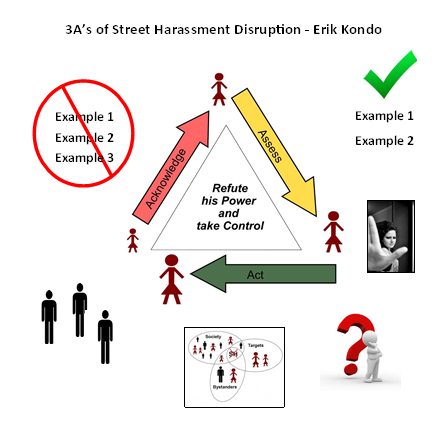
The 3A’s of Street Harassment Disruption
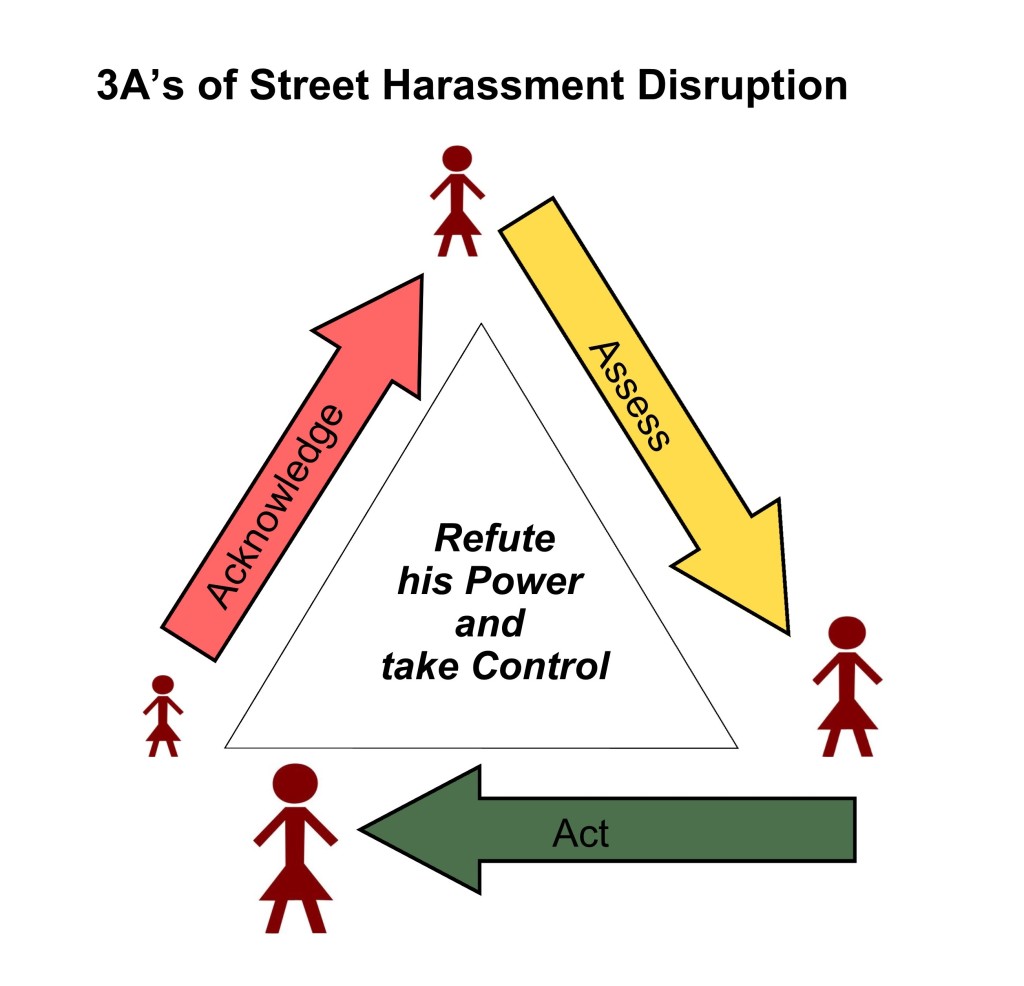
The 3A’s of Street Harassment Disruption are a plan to deal with Street Harassment as it occurs. They are designed to provide the Target of Harassment with a strategic response. The response is designed to have an effect on four entities.
1. Target – Provide the Target with a response that will make the Target feel better.
2. Harasser – Provide the Harasser with a response that discourages this type of behavior.
3. Bystanders – Provide a response that encourages Bystander support of Target.
4. Community – Provide a response that discourages Street Harassment in general in society.
Acknowledge
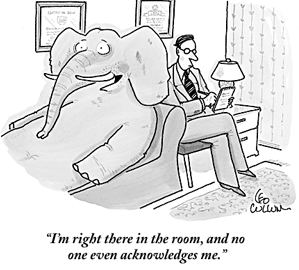
It is important for the Target and Bystanders to acknowledge that she or someone else is being targeted for harassment. And that harassing behavior is harmful not only to the Target, but to all those that witness it. Adolescents are most at-risk.
Assess

The Target and Bystander need to rapidly assess several factors in order to formulate the most effective response.
Assess what type Harasser is involved and what is the Harasser’s immediate Intention.
Assess the environment for intervening and mitigating factors such as other supportive Bystanders, police, or more Harassers.
Assess the Target’s and the Bystander’s realistic ability (strengths & weaknesses) to confront the Harassment.
Act

If there is no immediate threat to personal safety, the action should let the Harasser know that his behavior is unacceptable and will not be tolerated. To avoid escalating the situation, this message should not to be conveyed with anger, but with a strong voice and body language that leaves no doubt about the inappropriateness of the behavior: “Stop harassing me.”; “Don’t touch me.”; “Move away.”; and “Back off!” are examples of assertive phrases designed to deter some types of harassing behavior.
Response actions can be divided into three main types:
1. Visual - A signal from the Target using body language.
2. Verbal – Calculated words or phrases from the Target in response.
3. Physical – Physical movements from the Target in response.
The most effective responses will usually be Compound Actions and will use multiple types of Actions.
The idea here is to understand WHAT type of reaction the Harasser WANTS and give him one that is the most opposite to what he WANTS. For example, if he wants to shock and disgust you, you show amusement and contempt for his “ability” to shock and disgust.
The "Not interested!" Response

The majority of street harassment that is either visual or verbal and comes from men whose intentions range from seeking your attention, provoking a reaction from you, involving you in a visual fantasy, intimidating you, to testing your suitability for predatory behavior.
The problem with this type of harassment is that it makes you feel powerless and not in control of the situation. The problem with a knee jerk angry reaction such as “Fuck you, asshole”, is that it has the potential to escalate the harassment further. It also requires you to be angry in order to say it. In addition, “Fuck you asshole”, would seem out of place in response to the commonly used comment of “Hey, smile baby!” and is not appropriate around children.
Therefore, what you need is simple phrase that works for almost every situation. You need a response that puts you in control and in the position of power. It must be predetermined response that you can say quickly without having to formulate a sentence. A response that lets the harasser and any bystanders know that you are:
- Not interested in talking to him.
- Not interested in what he thinks.
- Not interested in what he does.
- Not interested in how he feels.
- Not interested in seeing his actions.
- Not interested in what he has to say.
- Not interested in being victimized by him.
- Not interested in explaining why you are not interested.
- Not interested in becoming upset by him.
- Not interested in feeling violated by him.
The response of “Not interested” is natural to say because it is most likely how you feel. Therefore, you are assertively communicating your feelings. “Not interested” is an unambiguous rejection of whatever the harasser has to offer or communicate. Therefore, you reject his “compliment” in the same manner that you reject his insult. You reject the harasser and his ability to have power and control over you. You let him and everyone else in the immediate vincinity know it.
Your statement of “Not interested” informs potentially helpful bystanders of the true nature of the situation and creates an opening for their intervention. Your statement allows you to refute the harasser and continue moving away from him. There is no need to stop and confront unless you choose to. You can simply look at the harasser coldly, say “Not interested” and continue on your way. “Not interested” is the first step of physical assertiveness.
Let’s see how “Not Interested” stacks up to commonly used harassing phrases and situations:
- “Hey mama!” – “Not interested.”
- “Do you need a ride?” – “Not interested.”
- “Why don’t you smile baby?” – “Not interested.”
- “I like the way you walk.” – “Not interested.”
- “I’d like to hit that!” – “Not interested!”
For added dramatic effect, you can add a dismissive wave of your hand.
- Kissing noises, hooting, hissing – “Not interested.” (dismissive wave)
- A car honking next to you as you walk – “Not interested.” (dismissive wave)
Feeling witty? You can add a second sentence.
- “Going my way?” – “Not interested. You’re not going anywhere.”
- “Can I be your boyfriend?” – “Not interested. Not in this lifetime anyway.”
- “I just want to say hi.” – “Not interested. I just want to say – bye.”
- “Why don’t you smile, beautiful?” – “Not interested. It’s because of people like you.”
- Masturbating in public. – “Not interested. But the police will be.” (as you take his picture)
“Hey honey, come suck my dick!”
Feeling angry and aggressive and want to throw caution to the wind? You could always add an insult qualifier such as:
- “Not interested. You piece of shit.”
- “Not interested. Dickhead.”
- “Not interested. You low life creepy fool.”
(NOTE: Using an insult is NOT the suggested response. These are examples that demonstrate the flexiblity of the “Not interested” response. Safety must always be your first priority.)
“Not interested” can always be followed by a verbal warning such as “Back off!”
- “Come here and let me touch your sweet ass!” – “Not interested. NOW BACK OFF!!”
- “Ah, come on over here, baby.” – “Not interested. I SAID I WAS NOT INTERESTED!!”
Find yourself in a work related or social situation and don’t want to come off too strong?
- “Boy, you are beautiful.” – “Not interested. Let’s focus on the getting the job done.”
- “Wow! You look fine.” – “Not interested. I don’t need compliments.”
“Not interested” also works for non-street harassment situations.
- Annoying phone calls. – “Not interested.”
- Aggressive sales people. – “Not interested.”
- Pesky men at a bar. – “Not interested.”
- Unwanted invitations – “Not interested.”
“Not interested” is your one stop, all purpose, predetermined, first response to street harassment. It puts you in control. Because it takes no conscious thought to say, you can say it quickly and while under stress. With a little practice, “Not interested” will become your automatic assertive response to most forms of street harassment.
Try it today and then pass it on!
Why it is so Hard to Respond to Street Harassment

Why it is usually so hard to respond to street harassment. Why “Not interested.” makes it easy.
The nature of verbal and visual street harassment makes it difficult to respond effectively. When the harassment comes in the form of a single unexpected comment or behavior, it most likely catches you by surprise. Therefore, you must mentally make the switch from whatever your were doing to determining what exactly is going on, and then formulating an effective response.This process is known as acknowledging and assessing.
Unfortunately, this process takes your conscious mind a few seconds to accomplish. As a result, in many instances, it is too late to respond effectively. Therefore, you end up ignoring the harassment.When you are able to foresee that some type of harassment is most likely forthcoming, you most likely attempt to deter the onset of the harassment by making a conscious effort to ignore the harasser. This effort combined with your uncertainty and apprehension about what might happen makes it difficult for you to think clearly and formulate an effective response. As a result, despite the extra time, you are still effectively “caught by surprise”.
The solution to both these instances is to have an automatic predetermined response that requires no conscious thought. One that eliminates the relatively slow mental process of acknowledging and assessing. In order for such a response to be used with confidence, the response must work for most types of visual and verbal harassment. In addition, the response must have minimal negative side effects associated with it. Having minimal negative side effects is critical, because that fact insures that you can safely use the response at the spur of the moment.
“Not interested!” is that response. It allows you to instantly respond and continue on your path away from the harasser. In the unlikely event, that the harasser was not directing his behavior at you, it doesn’t matter. No harm done. Continue on your way. If it was directly at you, then you have just let your harasser know that you are uninterested and unaffected by his behavior.
Unlike an angry retort, you have not provided the harasser a reason to escalate his harassment. If he chooses to continue, then he most likely would have done so anyway regardless of your response.
Example Response Scenario #1

This example provided is designed only to show how to use the 3A’s of Acknowledge, Assess, Act. The ACTIONS depicted are not necessarily the best responses. They are shown here to illustrate the concept of using a Visual, Verbal, or Physical response to a particular type of harassment from a particular type of harasser.
SCENARIO: You are walking down the sidewalk during the day and a man starts complimenting you on how good you look. You ignore him and continue walking, but he starts to follow you and continues his verbal banter.
STEP #1:
Acknowledge – Yes. He is directing his attention at you. What is happening is flattering, commenting, and following harassing behavior.
STEP #2:
A. Assess the Intention - What is the Intention of the Harasser? Seek Attention - He wants to engage with you.
B. Assess the Harasser – What type named harasser does this type of behavior? Charmer Wannabe.
C. Assess the Environment – Other people around, but no one else is paying attention.
D. Assess yourself – You are NOT afraid or intimidated. You want to respond to and take control of the situation.
STEP #3
A. Act with a Visual Response – You look at him directly and coldly.
B. Act with a Verbal Response – You make a statement to the effect of "Do not bother me!"
C. Act with a Physical Response – You look at him directly and coldly, you put up your hands and make a "move back motion".
The most effective response is a compound action that involves the combination of (A), (B), and (C).
These actions demonstrate Physical Assertiveness (The Progressive Fence) designed to deter the onset of aggression. The ACTUAL response will vary depending upon the circumstances and the nature of the people involved. The idea is to provide a FLEXIBLE STRATEGY as opposed to a canned response.
Example Response Scenario #2

This example provided in only designed to show how to use the 3A’s of Acknowledge, Assess, Act. The ACTIONS depicted are not necessarily the best responses. They are shown here to illustrate the concept of using a Visual, Verbal, or Physical response to a particular type of harassment from a particular type of harasser.
SCENARIO: You are walking down the sidewalk during the day and a man opens his coat and exposes himself in your direction.
STEP #1:
Acknowledge – Yes. It was not a mistake and it was directed at you. What just happened? It was Exposing harassment behavior.
STEP #2:
A. Assess the Intention - What was the Intention of the Harasser? Provoke Reaction - To shock and disgust you, thus providing power to the Harasser.
B. Assess the Harasser – What type named harasser does this type of behavior? The Pervert.
C. Assess the Environment – Other people around, but no one else saw it.
D. Assess yourself – You are NOT afraid or intimidated. You want to respond to both make yourself feel better and make the Harasser feel worse.
STEP #3
A. Act with a Visual Response – You look at him with contempt and make the universal sign of a “tiny penis”. You chuckle as you walk away.
B. Act with a Verbal Response – You look at him with contempt and say “Pathetic”. You chuckle as you walk away.
C. Act with a Physical Response – Take a picture to provide the pooice. Chuckle as you walk away.
As before, the ACTUAL response will vary depending upon the circumstances and the nature of the people involved. The idea is to provide a FLEXIBLE STRATEGY as opposed to a canned response.
The main point of both examples is to provide an assertive response that communicates your displeasure as opposed to either ignoring the harasser or reacting with anger. This type of response demonstrates that you are not intimidated by the harasser and you refuse to be controlled by him. You establish control of the encounter by voicing your feelings in a calm but direct manner. Once you have made your statement, the best strategy is to firmly walk away.
Ineffective Response - Example #1
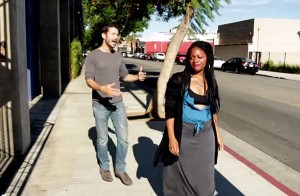
SCENARIO- The Charmer Wannabe with the intention of Seeking Attention
Harasser: “Looking good honey!”
Target: “Fuck you asshole!”
Harasser: “Oh, ya? I’ll fuck you bitch!!”
There are many profiles of street harassers and there are many types of street harassment behaviors. This writing will address dealing with harassment from Harassers whose intention is to either Seek Attention, Provoke a Reaction, or to create Fear & Intimidation. Rather than having an intention of a Visual Fantasy, Self-Pleasure, or Predatory Testing.
The goal of disrupting an incident of street harassment is to provide a response that has the direct effect of the following:
- a. Providing the Target a means to assert her displeasure with the behavior.
- b. Provide the Harasser a response that deters future harassment behavior.
- c. Provide Bystanders with actionable information in order for them to support the Target.
- d. Provide society with one example of how to effectively deal with street harassment.
Referring to the incident above, the Harasser is most likely a Charmer Wannabe. The intention of the comment is to Seek Attention from the Target. He feels that his only means of exerting Power & Control to make the Target recognize his presence is by making forced sexual comments to her.
The Target on the other hand most likely has been victimized by these types of comments over a long period of time—she is fed up. She considers the comment to be disrespectful and an insult. Therefore, she reacts to the “insult” with angry profanity. This reaction satisfies (a) above. She has voiced her displeasure. But it is possible that this satisfaction is only momentary as the Target reviews her reaction.
Referring to (b), the Harasser now feels that he has been unjustly insulted. He had “offered a compliment” and received an insult. Therefore, his reaction is also anger. He now escalates the harassment with the intention of now making the Target feel Fear & Intimidation. The response has not deterred his behavior. The Harasser has only changed his method of harassment.
In regard to (c), Bystanders who observe this interaction see mainly an angry confrontation with no clear aggressor or victim. Therefore, the most likely response will be to not get involved.
In regard to (d), the simple fact that this incident has escalated towards violence is proof that it is not an example for Society to follow.
A response that satisfies (a), (b), (c), (d) is a verbally assertive response combined with strong body language that conveys to the Harasser in no uncertain terms that his behavior is:
Unappreciated and disrespectful
- To the Target
- To women in general
- To others who are forced to see and hear it
The response does not need to be a lecture. It can be simple and quick, something along the lines of:
- “Don’t say that. Women do not like it”.
- “Learn to be polite. Next time just say hello”.
- “Not interested!”
- Any phrase that comes across as assertive and not angry, but still conveys how you feel about the comment.
Based upon the initial comment, it is reasonable to assess that the Harasser’s intention is Seeking Attention. Most likely, he is a Charmer Wannabe or a Peacocking Showoff. Despite the ineffectiveness or illogic of his method, he is hoping for some type of “ego boosting” response from the Target.
Therefore in his mind, the angry reaction from the Target is more than just a rejection, it is an uncalled-for insult. He reacts with his own anger. His intention is now to create Fear & Intimidation in order to teach the Target a Lesson. The Target on the other hand has reacted in exactly the same manner. Her reaction was also designed to teach the Harasser a lesson. These two diametrically opposed viewpoints now collide and escalate the situation.
An assertive response is not an insult, nor is it designed to teach a lesson. It is a statement of fact and perception. When used properly, it de-escalates situations. It clearly conveys your message and feelings. If the Harasser denies his behavior or attempts to defend it as being a compliment, “Aw, can’t you take a compliment?”, you need to recognize that the Power & Control dynamic has just flipped to your favor. Terminate the encounter with a statement such as “It is disrespectful behavior.” and leave.
Every situation of street harassment contains a different Power & Control dynamic. There is no one response that works every time. But invoking anger means losing control. It is very hard to gain control over a situation when you are simultaneously losing control too.
Ineffective Response - Example #2

Scenario – The Crude Oaf with the intention to Provoke Reaction
Harasser: “Nice tits!"
Target: “Fuck you asshole!”
Harasser: “Your ass looks pretty good too!!”
In the example above, it is most likely that the Harasser is a Crude Oaf with the intention of Provoking Reaction. The Crude Oaf knows that there is no chance of receiving a positive response from you. Therefore, he makes his presence known with an undeniable offensive remark. If you ignore him, he has proven his dominance. If you react with anger, then he knows that his tactic works. Therefore, he gives you another offensive remark.
The Crude Oaf is a tough nut to crack. But the undeniably offensive nature of his comments will also alienate him from Bystanders. Since he wants either an angry or intimidated reaction from you, he should get a cold, cool, calculated response. One that states that his behavior is weak and pathetic and, therefore by extension, so is he. You are effectively denying his ability to have Power & Control over you.
- “Your behavior is pathetic.”
- “Stop harassing women and go home!”
- "Not interested!"
As before, use any phrase that comes across as assertive and not angry, but still conveys how you feel about the comment. Unlike the Charmer Wannabe or the Peacocking Showoff, the Crude Oaf can’t deny his intention or pretend it was a compliment. Therefore, he may be shocked into silence, or he may morph into an Overgrown Bully. In either case, you need to firmly exit the situation. Do not continue to engage against the Overgrown Bully.
Ineffective Response - Example #3

Scenario – The Overgrown Bully with the intention of Fear & Intimidation.
Harasser: "Nice tits, bitch!”
Target - “Fuck you asshole!”
Harasser: “Oh, ya. I’ll fuck you, bitch! Now!!”
The Overgrown Bully makes his intention clear with his comment. He wants to threaten and intimidate you. An angry reaction just gives him more incentive to raise the stakes. As with the Crude Oaf, your reaction of anger or intimidation is a confirmation of his power. The Overgrown Bully is actually threatening you. Therefore, your response needs to deter the onset of further aggression. Your response needs to be calculated to end the threat and make Bystanders aware of your situation.
- “Stay away!”
- “Back off!!”
- "Not interested!!"
These statements must be combined with powerful body language. You must use physical assertiveness to convey a “do not mess with me attitude!”
Your goal should be to end the encounter and to exit the situation. This is not the time to express your anger or indignation. Exit, and go to the police. Tell them you were threatened on the street.
Fortunately, encountering the Overgrown Bully at the outset is much rarer than the other types of harassers. It is important to realize that all harassers have the potential to morph into the Overgrown Bully or worse. Therefore, regardless of your right to be angry, your goal is to avoid reacting with anger. When it comes to confrontations, anger is the accelerator, assertiveness is the brake.
3 Petal Plan to Defeat Street Harassment

Street harassment is a problem because it is disrespectful, inappropriate, and threatening behavior to adolescent girls and women in public places. This behavior has the greatest negative effect on the well-being of adolescent girls some of whom become conditioned to become silent, submissive, and fearful as opposed to becoming assertive, self-reliant, and confident.
Defeating street harassment requires a 3 Petal Plan that involves a combination of actions represented by the petals of Society, Targets of Harassment, and Bystanders. While each petal has a different role, they must all work together in order to create a lasting effect.
- Society must create a culture of intolerance for street harassment in order to eliminate the behavior.
- Targets of Harassment must learn strategies and methods to directly voice their disapproval when harassed.
- Bystanders - must learn strategies and methods to intervene and mitigate when observing incidents of harassment.
Every situation of street harassment is different. Each situation requires a different response. But the overall strategy is the same: Society, Targets, and Bystanders need to communicate that street harassment is unacceptable behavior and will not be tolerated.
Male Bystander Intervention
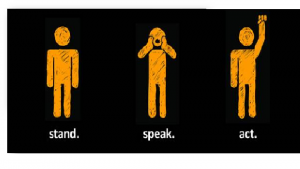
No writing on street harassment is complete without an examination of the role of male bystanders. In this case, the bystanders are defined as being neither participants, nor friends or associates of the harasser. The bystanders are strangers with no ties to either the Target of harassment or the Harasser.
The question of why bystanders, especially men, failed to take any action to intervene during or after an incident of harassment is quite common. The typical feeling is that the male bystanders either don’t care or are afraid to get involved. This answer may be fundamentally true, but it avoids the deeper questions of what will make the bystanders care more, or cause them to overcome their fear, and thus get involved.
In order for a bystander to take any kind of action, he first needs to have a clear indication that action is needed. While the harassment may seem very obvious to the Target of harassment, to the bystanders the situation is much less clear. If the harassment consisted of a one time event such as a disrespectful comment or unwanted touch, the bystanders may have been completely unaware of its occurrence. Even if the harassment involves a continual invasion of the Target’s personal space, it still may not be clear to the bystanders that there is a definite problem.
It is important to examine the event from the male bystanders’ perspective. In general, men need a concrete signal that their intervention is needed and wanted. They need to have confirmed in their mind that the Harasser has bad intention. And even after they have confirmed the Harasser’s bad intention, they need a trigger event to cause them to act. Without these elements being present, the bystanders will most likely remain in an internal indecision limbo of deny, delay, and do nothing.
What also needs to be understood is that while a situation that requires bystander intervention may seem incredibly obvious to a woman, it may seem harmless to a man. The man may perceive that the Target is in no immediate physical danger, therefore there is no need for him to intervene. The Target on the other hand may feel threatened and is looking for both moral support and physical backup.
The male bystander is uncertain as to what exactly has or is happening. He is uncertain as to whether there is some type of unknown relationship between the Target and the Harasser. He is uncertain as to whether his offer to intervene will be desired or will be rejected by the Target. He is uncertain of what he should do if he intervenes. He is uncertain as to whether his intervening will escalate the situation even further. He is uncertain as to how the other bystanders will react to his intervention. All of this uncertainty compounds into a generalized fear of not intervening. As a result, the easiest action to take is no action at all.
It is very easy for a male bystander to take the position that whatever happened has “already happened”; therefore, it is too late to do anything about it, anyway. The Target on the other hand may simply be looking for a confirmation of her feelings about the inappropriateness of the behavior from the bystanders.
Male bystanders are more likely to intervene in a situation of street harassment when the Target of harassment makes it clear as to what has happened, why it is a problem, and that bystander intervention is desired. This information will provide the male bystander with confirmation of the Harasser’s bad intention along with the trigger necessary to cause him to act. This information can be provided by an assertive statement from the Target directed to the Harasser stating “Stop harassing me. I don’t like it.” This statement is actionable information and removes a large number of uncertainties.
On a personal note, I believe that the statement “Stop harassing women. No woman likes it.” is less likely to induce male bystander intervention. I feel the reason is that this statement is more of a general reprimand. The Target seems to have the situation under control. Therefore, maybe no male intervention is needed or desired.
In any case, the two main uncertainties that remain are what exactly the Bystander should do, and will his intervention make the situation worse? The first one can be eliminated by an additional command from the Target to the Harasser such as “Not interested!", Leave me alone!”, Move away!”, or “Back off!”. The Bystander now knows that his role is to physically create a barrier between the two, or to add an additional supporting command of his own such as “You heard her, move away from her!”
We are now left with the final uncertainty. The one that all harassers depend upon to keep both targets and bystanders in fear. It is the implicit fear that the harasser may at anytime erupt into violence that the harasser uses to his advantage, enabling him to gain power and initial control of the situation.
It is for this very reason that it is important to profile and assess the Harasser in order to determine the likelihood of his escalating the situation into violence. It is not true to say that “all harassers are bluffing” because they are all not bluffing, but when confronted with an assertive Target and supportive bystanders, most harassers are bluffing. When confronted in this manner, the Harasser needs to make a choice: he can either escalate the harassment to threats and thereby risking an angry mob of bystanders, and incurring criminal penalties, or he can back down.
In the event the Harasser backs down, the Target has won. Both the Target and the Bystander need to stand firm and allow the Harasser to make his exit. Over-intervention on the part of either the Target or Bystander may change the dynamic of the situation so much that now the Harasser is the one that feels threatened and reacts. This type of situation should be avoided.
If the Harasser does not back down when faced with both an assertive Target and Bystander, the Harasser may be an Overgrown Bully, Anti-Social Intimidator, or worse. This type of person is comfortable with the use of violence to gain advantage. Therefore, the Target and Bystander need to jointly disengage and exit from the Harasser in an orderly manner. Upon creating a safe distance, it is an excellent opportunity to alert the police as to the nature of the incident.
In summary, male bystanders are not necessarily uncaring or afraid. They may simply be uncertain as to when and how to proceed. If they are provided with clear indications and directions, it is much more likely that they will intervene on behalf of the Target in a situation of street harassment.
Video Links
Power and Control

The foundation of many female concerns about street harassment is that due to men’s physical superiority they can resort to violence at any time. Therefore, men always have the upper hand. The belief is that men have the power and control in all interactions.
But human interactions are rarely that simple. The average man maybe bigger and stronger than the average woman. But averages don’t interact. People do. At any given time, a woman could be carrying any number of weapons (firearm, knife, stun gun, pepper spray, etc.) that would provide the woman with a physical advantage over the man. If power and control is determined only by who has the greater ability to inflict physical injury (it's not), then women could flip the dynamic.
In addition, just as a man could physically attack a woman if he chooses to, so could a woman claim she was inappropriately touched by a man if she chooses to. The consequences of such a claim to the man would be very detrimental and permanent regardless of what actually happened. In reality, most men have no intention of attacking a woman and most women have no intention of making a false accusation. Just because someone has the ability to do something, doesn’t make it a likely possibility.
Street Harassers rely on their Targets to overestimate the likelihood that they will resort to violence. They use this overestimation to establish and maintain power and control over their Targets.
In their quest to fight against street harassment, many anti-street harassment organizations promote the belief that street harassers are likely to resort to violence when confronted. They do this to inflate the perceived danger to women in order to gain support for their cause. While this is an effective “marketing” strategy for their cause, it has the effect of harming individual women’s ability to accurately assess risk.
The purpose of the 3A's is to provide Targets of street harassment with a strategy to maintain power and control over the interaction.